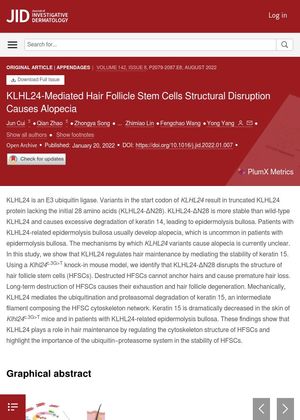TLDR A faulty KLHL24 gene leads to hair loss by damaging hair follicle stem cells.
The study explores the role of KLHL24 in hair follicle stem cells (HFSCs) and its link to alopecia. KLHL24 mutations result in a more stable protein that degrades keratin 15, crucial for HFSC structure. Using a knock-in mouse model, researchers found that this disruption leads to premature hair loss and HFSC exhaustion. The findings highlight KLHL24's essential role in maintaining HFSC integrity and suggest that its excessive ubiquitination of keratin 15 is a key mechanism in alopecia, with potential implications for other hair loss disorders.
142 citations
,
February 2016 in “Science” Foxc1 helps keep hair follicle stem cells inactive, preventing hair loss.
 375 citations
,
February 2006 in “Journal of Cell Science”
375 citations
,
February 2006 in “Journal of Cell Science” The document concludes that the hair cycle is a complex process involving growth, regression, and rest phases, regulated by various molecular signals.
387 citations
,
November 2003 in “Journal of Investigative Dermatology” The K15 promoter effectively targets stem cells in the hair follicle bulge.
50 citations
,
July 2008 in “British Journal of Dermatology” 138 citations
,
March 2007 in “Experimental cell research” Only a few hair-specific keratins are linked to inherited hair disorders.
276 citations
,
January 2005 in “International review of cytology” More research is needed to understand how hair keratins work and their role in hair disorders.
 199 citations
,
January 2004 in “The International Journal of Developmental Biology”
199 citations
,
January 2004 in “The International Journal of Developmental Biology” Hair follicle growth and development are controlled by specific genes and molecular signals.
29 citations
,
April 2003 in “Experimental dermatology” Human hair follicles grown in vitro maintain normal keratin patterns and structure.
36 citations
,
December 1991 in “Journal of Dermatological Science” Human nails contain both skin and hair keratins, each needing different extraction methods.


